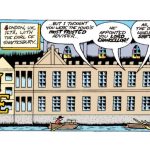On Wednesday, the Supreme Court issued a one-paragraph, unsigned order in a pair of redistricting cases from Louisiana, Robinson v. Callais and Landry v. Callais. The Court granted the application for a stay. Justices Sotomayor and Kagan would have denied the application, and Justice Jackson wrote a two-page dissent. Most readers probably assumed that the conservative Supreme Court helped the republican voters, and the progressives Justices would have done the opposite. Not quite. Indeed, this is one of the more confusing emergency docket cases I’ve seen. The upshot of the case is that there will be two black districts in the 2024 election, both of which will almost certainly go to Democratic candidates. Many press accounts struggled to make sense of this case, and the split. Why would the Court’s progressives dissent?
Rick Pildes offered a pithy description of the cases:
Two different federal courts had issued two decisions which left LA with no valid congressional map in place. The first federal court said LA’s original map violated the Voting Rights Act; the second federal court said the new map LA enacted to remedy the VRA violation itself violated the Constitution.
Today, the Court stayed that second decision. The effect of that stay is the state’s remedial map — which creates 2 VRA districts rather than just the 1 the state had created initially — will be the map LA uses this fall.
Let’s summarize. White voters argued that the maps from the first court violated the Equal Protection Clause, and wanted the maps from the second court to go into effect. But Louisiana and the black voters asked the Court to stay the second decision to avoid confusion, so that the maps from the first court will go into effect for the upcoming 2024 election. The Supreme Court stayed the second court, citing the Purcell principle. Louisiana and the black voters prevailed, and the white voters lost.
Shouldn’t this have been a unanimous decision? Why then did Justices Sotomayor and Kagan deny the application for a stay? Why did Justice Jackson dissent? They really, really do not like Purcell. So much so that they would have allowed the lower-court proceedings to continue in (checks notes) the 5th Circuit, to avoid setting a new emergency docket precedent (if such a thing can exist). To be sure, the troika would have likely found the first court’s maps constitutional, and would have stepped in later. But they were not willing to accept a unanimous decision if doing so would create a precedent for invoking Purcell about six months before the election.
Here’s the most intriguing question: What would have happened if Justices Thomas, Alito, and Gorsuch had declined to grant a stay, on the grounds that the first court’s maps were unconstitutional? Roberts, Kavanaugh, and Barrett would not have had enough votes to stay the second court. At that point, I suspect that Justices Sotomayor and Kagan would have quietly slid up to the majority, allowing Justice Jackson to stand up for the principle in dissent. But that didn’t happen. Justices Thomas, Alito, and Gorsuch are committed to Purcell, even where it means employing likely-unconstitutional maps in a congressional election. Whoever insists this is an all-Republican Court should carefully scrutinize this order.
The post Why did Justices Sotomayor, Kagan, and Jackson Dissent in <i>Robinson v. Landry</i>? appeared first on Reason.com.






